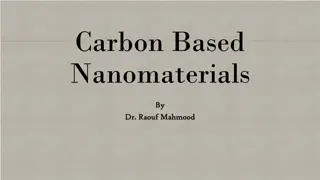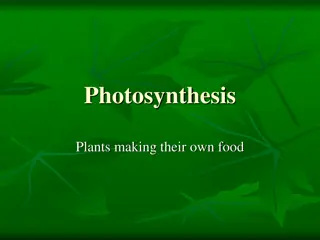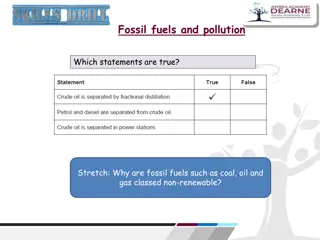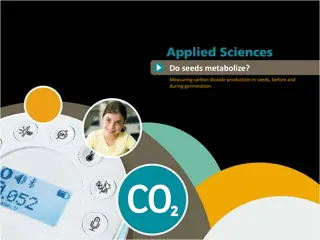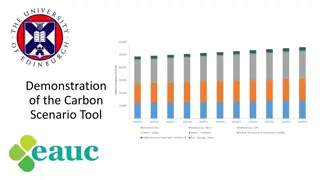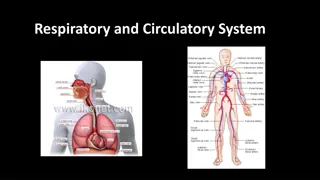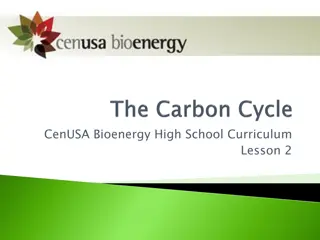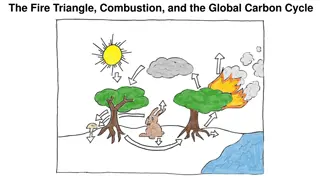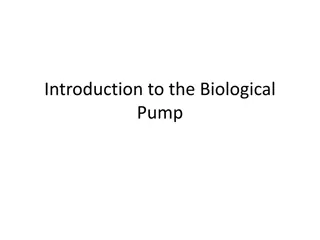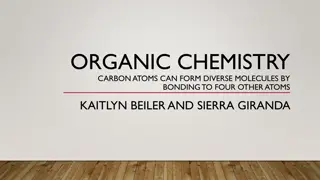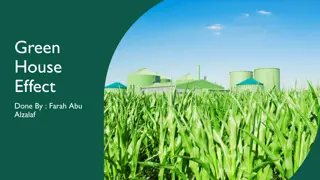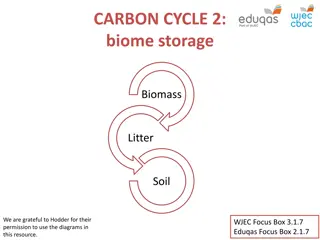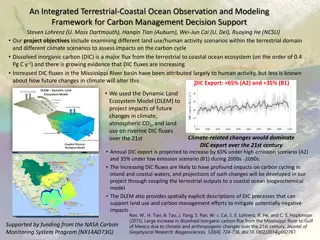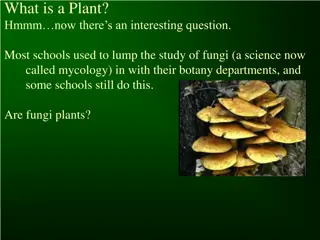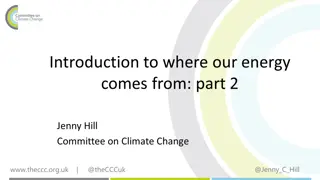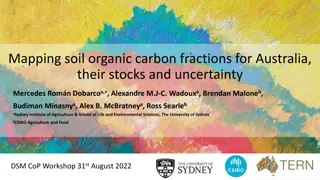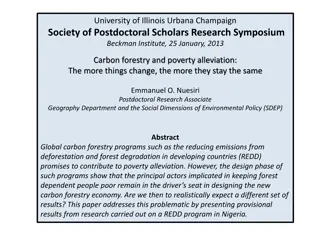Insights on Carbon Dioxide and Its Benefits
This content delves into the various aspects of carbon dioxide - from its role in the greenhouse effect to its beneficial properties and common uses. Explore the significance of CO2 in our atmosphere, its non-toxic nature, and how it contributes to familiar products like carbonated drinks and fire extinguishers. Uncover the reasons behind CO2's prevalence in certain applications and its unique solubility characteristics.
Download Presentation

Please find below an Image/Link to download the presentation.
The content on the website is provided AS IS for your information and personal use only. It may not be sold, licensed, or shared on other websites without obtaining consent from the author.If you encounter any issues during the download, it is possible that the publisher has removed the file from their server.
You are allowed to download the files provided on this website for personal or commercial use, subject to the condition that they are used lawfully. All files are the property of their respective owners.
The content on the website is provided AS IS for your information and personal use only. It may not be sold, licensed, or shared on other websites without obtaining consent from the author.
E N D
Presentation Transcript
These slides contain animations, when the PowerPoint file is played The content gradually appears with clicks Questions appear before their answers
Carbon Dioxide Its not all bad Carbon dioxide results from the combustion of carbon containing fuels (= most of the ones we use) As a consequence, we have certainly heard about carbon dioxide (CO2) as the main culprit for the greenhouse effect and global warming It is a problem because we are emitting truly massive amounts of it into the atmosphere from combustion (37 billion tons in 2023) However, it is a very useful substance with many attractive properties It is effectively non-toxic It is chemically stable It has useful melting/boiling/critical points https://www.climate.gov/news-features/understanding-climate/climate-change-atmospheric-carbon- dioxide#:~:text=Since%20the%20middle%20of%20the,the%20Global%20Carbon%20Budget%202023.
Carbon Dioxide Its not all bad As a gas that is part of our normal physiological functioning, it is not particularly toxic. The air we breath out contains about 5% CO2! Composition of air during breathing Inhaled Exhaled N2 O2 Ar 78% 78% 21% ~16% 1% 1% CO2 H2O 0.04% ~5% varies saturated What else changes between inhaled and exhaled air?
Carbon Dioxide Its not all bad CO2 is a very useful substance with many attractive properties Name some familiar uses of CO2: Drink carbonation Fire extinguishing Refrigerant dry ice Leavening (raising) bread CO2 lasers As a green solvent
Carbon Dioxide Drink Carbonation Sodas and other sparkling drinks get their bubbles from carbon dioxide Why not use some other gas to make drinks bubbly? Some reasons: Toxicity clearly a problem! (e.g. NH3, SO2, H2S, CO, NO2) Odor 4/5 of the examples above (NH3, SO2, H2S, NO2 also have unpleasant odors) Cost CO2 is quite cheap and readily available Solubility - the gases from air (N2, O2, Ar) meet the criteria of low toxicity, no odor, and low cost. However, they have very poor solubility in water.
Carbon Dioxide Drink Carbonation Why not use some other gas to make drinks bubbly? Solubility CO2 has good solubility in water. Henry s Law tells us that the amount of gas that can dissolve in a liquid is proportional to the pressure of the gas above the liquid. We see this when opening a soda bottle, the pressure over the liquid reduces and so the CO2 solubility reduces, leading to gas coming out of solution in the form of bubbles Also, a small amount of CO2 reacts with water: CO2 + H2O H2CO3 H2CO3 is an acid, making the water more acidic (pH 3-4). This contributes to the flavor of carbonated drinks and water.
Carbon Dioxide Drink Carbonation How does the CO2 get in the drinks? Some drinks, like soda, are pressurized with CO2 e.g. from a gas cylinder A typical soda can or bottle is pressurized to about 30-50 psi at room temperature. That s around 2-3 times atmospheric pressure http://img1.targetimg1.com/wcsstore/TargetSAS/img/p/12/97/12979694.jpg http://www.ezcreditwarehouse.com/rims/images/tire_KU31.jpg Soda bottle ~3 atm Narrow Bike Tire 6-8 atm Propane tank 10-13 atm Nitrogen cylinder ~145 atm Car Tire ~2 atm Inflating a balloon - ~ 0.1 atm
Carbon Dioxide Drink Carbonation How does the CO2 get in the drinks? Other drinks, like beer and champagne, get their CO2 from the fermentation process that produced their alcohol: C6H12O6 2 C2H5OH + 2 CO2 sugar ethanol https://images.app.goo.gl/WxYZdZrS7jr1okNCA https://physicsworld.com/a/six-secrets-of-champagne/
Carbon Dioxide Fire Extinguishing CO2 is used in some fire extinguishers It works by displacing air - no oxygen, no fire https://images.app.goo.gl/oMfufQxYDnYK7SrT7 CO2 is not flammable; it is already the product of combustion! e.g. CH4 + 2 O2 CO2 + 2 H2O methane
Carbon Dioxide Fire Extinguishing CO2 gas at atmospheric pressure is more dense than air so it tends to sink and smother a fire Density - Air 1.29 kg per m3 CO2 1.98 kg per m3 It can t absorb much heat, like water can. So, fires can reignite when the CO2 disperses, so it is best suited to small fires. What makes it a better choice than water for electrical fires? https://images.app.goo.gl/oMfufQxYDnYK7SrT7
Carbon Dioxide Fire Extinguishing Some other facts about CO2 and fire extinguishing: CO2 is not flammable, but it can serve as an oxygen source for some very reactive substances, like reactive metals. It can t be used on that type of fire because it can make the fire worse! e.g. 2 Mg + CO2 2 MgO + C (+ heat) A CO2 fire extinguisher is at sufficient pressure to liquefy the CO2 inside (59 atmospheres at room temp). Interestingly, some older fire extinguishers worked by mixing acid with sodium bicarbonate. That reaction releases CO2, but its major function in that case was to pressurize the container to squirt the liquid (mostly water) out at the fire e.g. -HCO3(aq) + H+ (aq) H2CO3 H2CO3 CO2 (g) + H2O
Carbon Dioxide Dry Ice https://images.app.goo.gl/eqQy3Cd2k2bb6K619
Carbon Dioxide Dry Ice CO2 does not exist as a liquid at atmospheric pressure Instead, if cooled sufficiently (-78 C) it changes directly from a gas to a solid dry ice Dry ice is useful as a cooling agent What are some advantages of dry ice vs water ice? It can cool things to a much lower temperature than water ice Water ice melts leaving a liquid that has to be dealt with As dry ice sublimes (equivalent term to evaporates when talking about the solid gas phase change) the gas diffuses away, leaving no residue to deal with
Carbon Dioxide Leavening Leavening adds volume to baked goods (bread, cake, etc.) Bubbles of gas (usually CO2) expand within the dough or mix, raising it When the mixture sets, the trapped bubbles are responsible for the sponge-like structure that we see in bread and cake. https://t1.gstatic.com/licensed-image?q=tbn:ANd9GcQwu9l5QEVRGPd9- hQ90jhpiGAMg1ycT46XWkXivXoCYaZ2RUm0Fz_Y0ZVxsJ50o3_K
Carbon Dioxide Leavening There are two common ways that the CO2 gas is produced: 1. Biological Baker s yeast The fermentation reaction produces CO2 and ethanol. The process is usually slower than with the chemical leavening agents C6H12O6 2 C2H5OH + 2 CO2 sugar ethanol 2. Chemical Bicarbonate + acid Baking powders contain a bicarbonate salt (e.g. NaHCO3) an acid salt (e.g. potassium acid tartrate (cream of tartar) KC4H5O6), and starch powder (to keep the salts from getting wet and from contacting each other). When the mixture gets wet the following reactions occur: e.g. -HCO3(aq) + H+ (aq) H2CO3 H2CO3 CO2 + H2O
Carbon Dioxide Lasers The carbon dioxide laser is one of the most useful laser types They are used in industrial and medical applications https://images.app.goo.gl/T3d4dWF2ikLdxpTa6 https://en.wikipedia.org/wiki/Carbon-dioxide_laser
Carbon Dioxide Lasers It is a gas laser where CO2 is the radiative emitter It is easy to produce high power levels at reasonable cost They are used for industrial cutting and welding They are also used for medical applications, such as in laser surgery to cut, ablate, vaporize, and coagulate The emitted laser light is infrared, it is invisible! https://en.wikipedia.org/wiki/Carbon-dioxide_laser
Carbon Dioxide A Green Solvent We know that CO2 is a gas and that dry ice has the unusual property of subliming (phase changing directly from a solid to a gas) at normal pressure But CO2 can certainly exist in liquid form and also finds use when in a supercritical state From this image What is the lowest pressure required for CO2 to exist as a liquid? What pressure is required for CO2 to be a liquid at room temperature? https://en.wikipedia.org/wiki/Carbon_dioxide
Carbon Dioxide A Green Solvent Supercritical What does that mean? Above the critical point temperature, a substance cannot be liquified, at any pressure. Supercritical fluids display properties of both liquids and gases. Fills the volume of its container, like a gas Can more effectively dissolve other substances, like a liquid https://en.wikipedia.org/wiki/Carbon_dioxide
Carbon Dioxide A Green Solvent Supercritical CO2 is used as a solvent A substance that is dissolved can be recovered by releasing the pressure, all the CO2 will evaporate away! For example, supercritical CO2 can be used to extract caffeine from coffee This is a greener process than using the major alternative, methylene chloride (CH2Cl2), which is toxic and an ozone depleting substance https://images.app.goo.gl/gYZkSdwh96Um75X39
Carbon Dioxide A Green Solvent Another example involves using supercritical CO2for dry cleaning This is also a greener alternative to the standard solvent, perchloroethylene https://images.app.goo.gl/6jTmj8smmpxgzTxT7
Carbon Dioxide A Green Solvent How can using CO2 as a solvent be green? Most importantly, it is safe and effectively non-toxic The reasoning is simple, CO2 is obtained from the environment If it is then, released back into the environment, there is no overall change to the amount in the environment This is very different to burning fossil fuels, which releases CO2 into the air that was not there before






